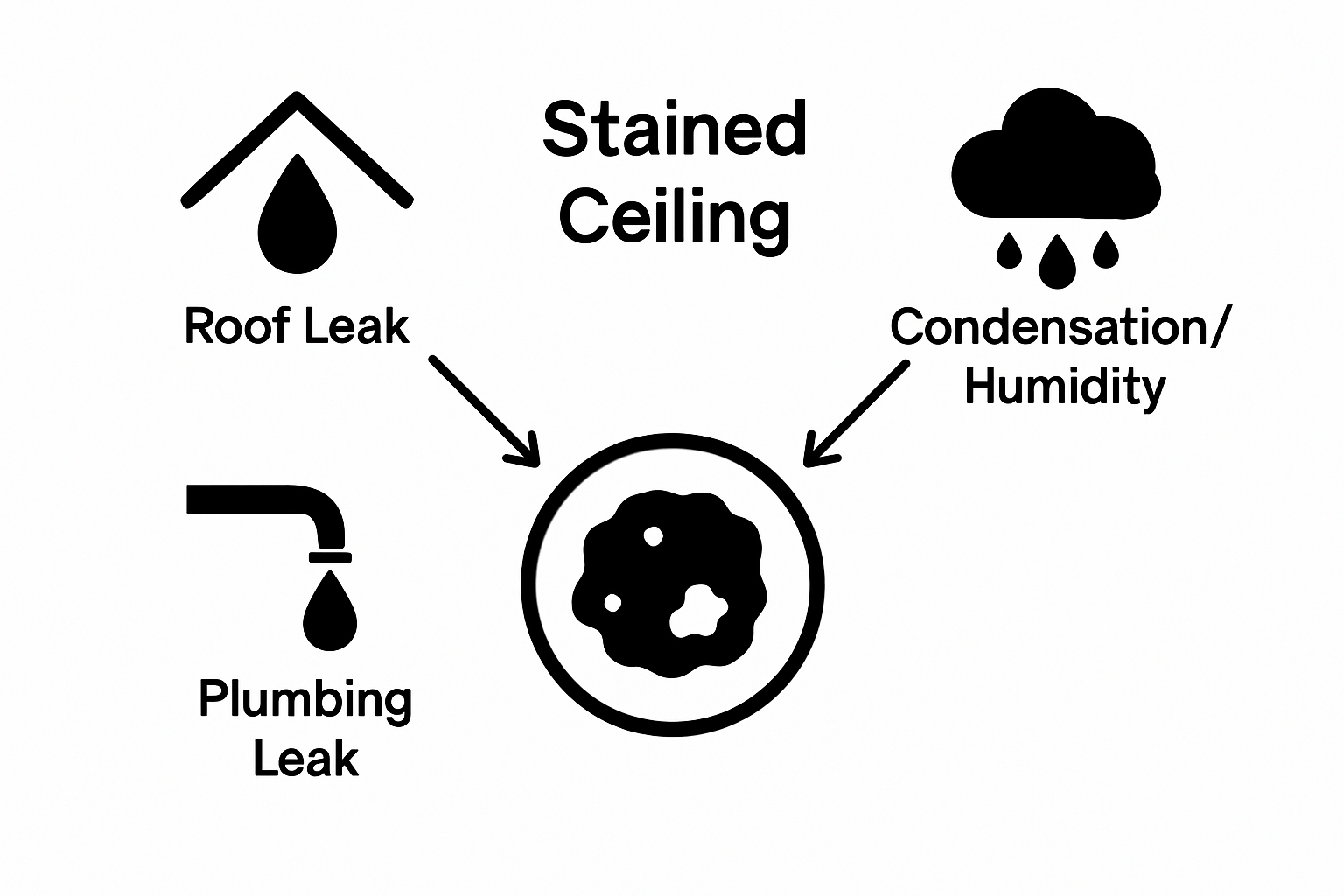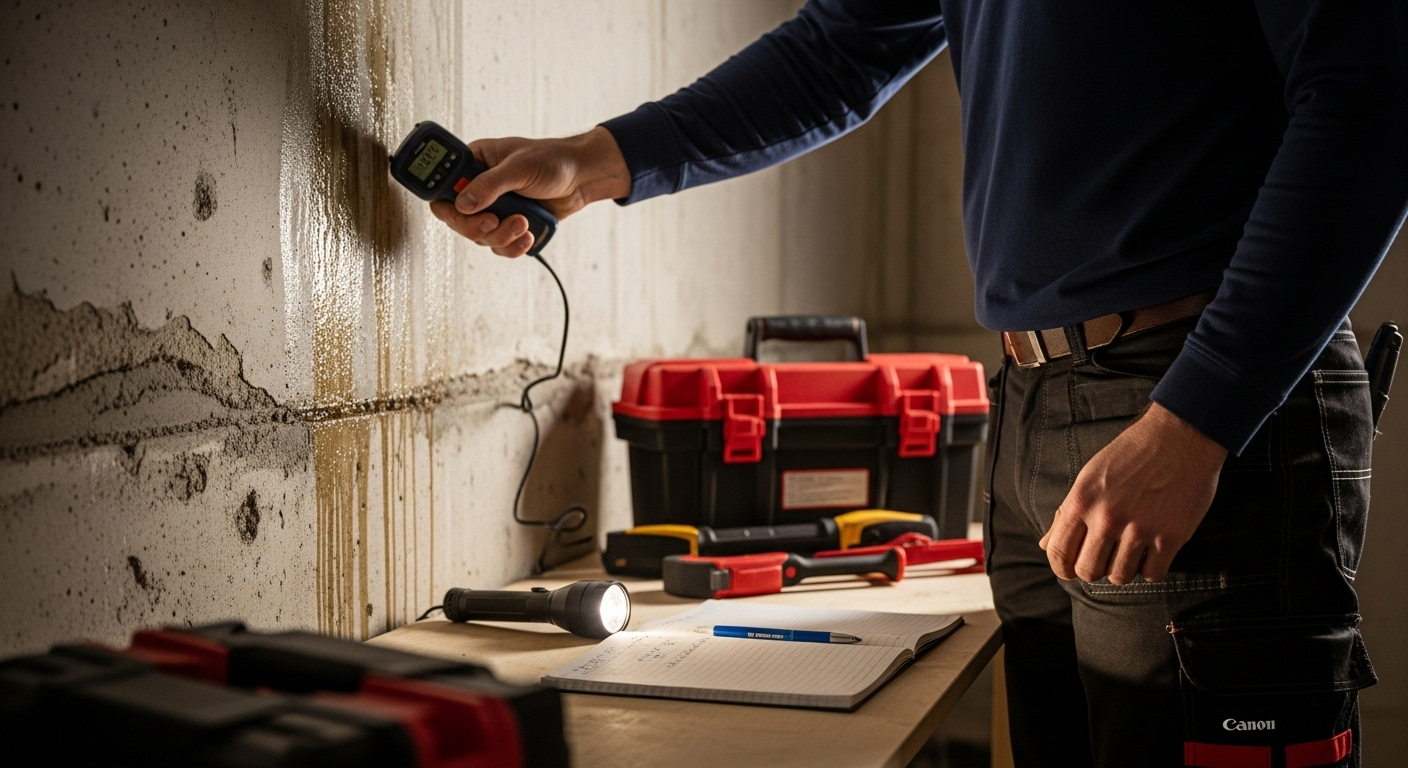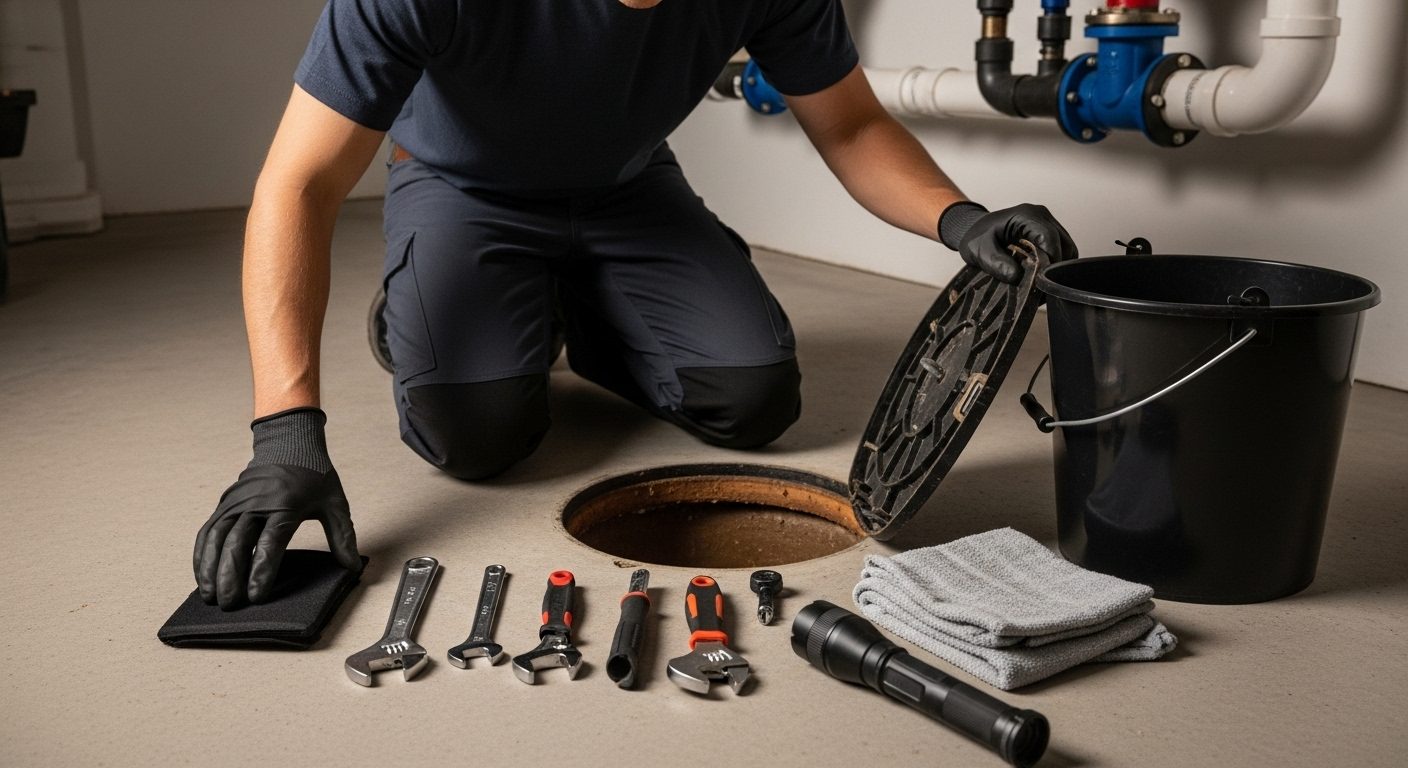Understanding Ceiling Stain Causes for Homeowners
Understanding Ceiling Stain Causes for Homeowners

Ceiling stains show up as ugly patches that seem to appear out of nowhere, leaving homeowners puzzled and uneasy. The surprise is how common they really are. Nearly every home will face ceiling stains at some point, often as a signal of underlying moisture issues. But the true shock comes when you learn these marks are more than just a cosmetic headache. They can quietly threaten your family’s health and the very bones of your house.
Table of Contents
- What Are Ceiling Stains And How Do They Form?The Science Behind Ceiling Stain Formation
- Types Of Ceiling Stains And Their Origins
- Common Reasons Behind Ceiling Stains In HomesMoisture Infiltration Pathways
- Indoor Environmental Factors
- Structural And Material Interactions
- The Importance Of Identifying Ceiling Stain CausesHealth And Safety Implications
- Structural Integrity And Property Value
- Long-Term Cost Prevention
- How Moisture And Humidity Impact Ceiling StainsHumidity Dynamics And Condensation Mechanisms
- Chemical Interactions And Material Responses
- Long-Term Environmental Impact
- When To Seek Professional Help For Ceiling StainsWarning Signs Requiring Immediate Professional Assessment
- Complex Moisture Source Diagnostics
- Long-Term Prevention And Mitigation
Quick Summary
| Takeaway | Explanation |
|---|---|
| Identify ceiling stains early | Early detection prevents minor issues from escalating into major structural problems over time. |
| Know the types of stains | Different colours indicate specific issues, helping diagnose the source of moisture or damage. |
| Humidity management is crucial | Proper indoor humidity control reduces condensation and moisture buildup, minimizing stain risks. |
| Seek professional help for complex cases | For expanding stains or structural changes, experts can diagnose and address underlying causes effectively. |
| Neglecting stains affects health | Moisture issues can lead to mould growth, posing serious health risks such as respiratory problems. |
What are Ceiling Stains and How Do They Form?
Ceiling stains are discoloured patches or marks that appear on your home’s ceiling surface, indicating underlying moisture or damage problems. These unsightly blemishes range from light brown spots to dark, spreading patches that can signal serious structural concerns.
The Science Behind Ceiling Stain Formation
Ceiling stains develop through complex interactions between moisture, building materials, and environmental conditions. Water intrusion is the primary mechanism driving stain creation. When moisture penetrates ceiling materials, it leaves behind mineral deposits, rust, or biological growth that creates visible discolouration.
Three primary mechanisms contribute to ceiling stain development:
- Water Leakage : Roof leaks, plumbing issues, or condensation allow water to seep through ceiling materials
- Humidity Interactions : High indoor moisture levels cause chemical reactions in building materials
- Temperature Variations : Thermal differences create condensation points where staining occurs
Types of Ceiling Stains and Their Origins
Ceiling stains manifest in different colours and patterns, each revealing unique diagnostic information about their underlying cause:
- Brown or Rust-Coloured Stains : Often indicate water containing high iron content or rusting metal components
- Yellow or Tan Stains : Typically signal water damage from roof leaks or pipe condensation
- Grey or Black Stains : Potentially indicate mould growth or serious moisture penetration issues
Understanding these visual cues helps homeowners diagnose potential structural problems before they escalate into significant repair challenges.
To help you better identify the nature and likely source of your ceiling stain, the following table summarizes common stain colours and their typical origins.
| Stain Colour | Likely Cause | Diagnostic Significance |
|---|---|---|
| Brown or Rust | Water with high iron content or rusted metal components | Indicates water infiltrating from roofing or plumbing |
| Yellow or Tan | Roof leaks or pipe condensation | Usually signals water damage from above |
| Grey or Black | Mould growth or persistent moisture infiltration | Suggests prolonged dampness and possible mould issues |
| Prompt identification and professional assessment can prevent extensive damage. | ||
Common Reasons Behind Ceiling Stains in Homes
Ceiling stains are more than aesthetic nuisances they represent complex interactions between building materials and environmental conditions. Understanding their root causes helps homeowners diagnose and prevent potential structural damage.
Moisture Infiltration Pathways
Moisture represents the primary culprit behind most ceiling stains.
 Water can penetrate ceiling structures through multiple pathways, creating distinctive discolouration patterns. These infiltration routes range from subtle condensation issues to significant structural breaches.
Water can penetrate ceiling structures through multiple pathways, creating distinctive discolouration patterns. These infiltration routes range from subtle condensation issues to significant structural breaches.
Key moisture infiltration sources include:
- Roof Leaks : Small roofing vulnerabilities allow water to seep through insulation and ceiling materials
- Plumbing System Failures : Hidden pipe leaks within walls can gradually saturate surrounding structures
- Condensation Buildup : Temperature differentials create moisture accumulation in enclosed spaces
Indoor Environmental Factors
Interior environmental conditions significantly contribute to ceiling stain development. High humidity levels, poor ventilation, and temperature fluctuations create ideal conditions for moisture accumulation and subsequent staining.
Critical environmental factors driving ceiling stain formation:
- Inadequate Ventilation : Restricted airflow traps moisture inside building structures
- Temperature Inconsistencies : Thermal bridges enable condensation at material interfaces
- Humidity Level Fluctuations : Rapid moisture content changes stress building materials
Structural and Material Interactions
Building materials themselves play a crucial role in ceiling stain manifestation. Porous materials like drywall and wood readily absorb and retain moisture, facilitating chemical reactions that produce visible discolouration.
Homeowners should recognize that ceiling stains represent complex signals of potential underlying issues. Prompt professional assessment can prevent minor moisture problems from escalating into significant structural damage, protecting both property value and occupant health.
The Importance of Identifying Ceiling Stain Causes
Ceiling stains are not merely cosmetic concerns but critical indicators of potential structural vulnerabilities within your home. Early identification and understanding of these stains can prevent extensive damage, protect your property value, and safeguard your family’s health.
Health and Safety Implications
Ceiling stains often signal underlying moisture problems that can create significant health risks. Prolonged moisture exposure enables mould and mildew growth, which releases spores that can trigger respiratory issues, allergic reactions, and other serious health complications.

Potential health risks associated with untreated ceiling stains include:
- Respiratory Problems : Mould spores can cause asthma attacks and chronic breathing difficulties
- Allergic Reactions : Airborne contaminants from moisture damage can trigger skin and respiratory allergies
- Immune System Challenges : Prolonged exposure to mould can compromise overall immune function
Structural Integrity and Property Value
Beyond health concerns, ceiling stains represent early warning signs of potential structural deterioration. Unaddressed moisture issues can compromise building materials, leading to significant and expensive repair requirements.
Key structural risks from ignored ceiling stains:
- Material Degradation : Continuous moisture weakens drywall, wood framing, and insulation materials
- Structural Compromise : Water infiltration can cause wood rot and metal corrosion
- Potential Foundation Issues : Persistent moisture problems might indicate more serious building envelope vulnerabilities
Long-Term Cost Prevention
Proactive identification of ceiling stain causes represents a strategic approach to home maintenance. Early intervention can transform potential major repair projects into manageable, cost-effective solutions.
Homeowners who invest time in understanding and addressing ceiling stains protect not just their immediate living environment, but also their long-term financial investment. Professional assessment provides comprehensive insights into the complex interactions between moisture, building materials, and environmental conditions that contribute to ceiling stain development.
How Moisture and Humidity Impact Ceiling Stains
Moisture and humidity play pivotal roles in creating ceiling stains, functioning as complex environmental triggers that transform seemingly innocuous indoor conditions into potential structural threats. Understanding these intricate interactions helps homeowners proactively manage their indoor environment.
Humidity Dynamics and Condensation Mechanisms
Indoor humidity represents a delicate balance between moisture production and environmental conditions. When humidity levels exceed optimal ranges, microscopic water particles begin accumulating on cooler surfaces like ceilings, initiating the stain formation process.
Key humidity factors driving ceiling stain development include:
- Temperature Differentials : Warm moisture encountering cooler ceiling surfaces creates condensation
- Airflow Restrictions : Poor ventilation traps moisture in confined spaces
- Daily Moisture Generation : Activities like cooking and bathing produce significant ambient moisture
Chemical Interactions and Material Responses
Building materials respond dynamically to moisture exposure. Porous surfaces like drywall and wood absorb water, triggering complex chemical reactions that manifest as visible stains. These interactions involve mineral deposits, organic compound transformations, and potential microbial growth.
Critical material response mechanisms include:
- Mineral Deposit Accumulation : Water transports dissolved minerals that leave distinctive staining patterns
- Organic Material Breakdown : Moisture accelerates degradation of organic building components
- Microbial Colonization : Sustained humidity enables mould and mildew proliferation
Long-Term Environmental Impact
Ceiling stains represent more than aesthetic concerns they are sophisticated environmental indicators. Persistent moisture conditions can compromise structural integrity, creating cascading damage that extends beyond surface discolouration.
Homeowners must recognize humidity as a dynamic system requiring continuous monitoring and strategic management. Professional assessment provides comprehensive insights into the nuanced interactions between indoor environmental conditions and building material responses that contribute to ceiling stain development.
When to Seek Professional Help for Ceiling Stains
Ceiling stains can rapidly transform from minor cosmetic issues to significant structural problems. Recognizing the critical moments when professional intervention becomes necessary helps homeowners prevent extensive damage and costly repairs.
Warning Signs Requiring Immediate Professional Assessment
Certain ceiling stain characteristics signal urgent need for expert evaluation. These indicators suggest potential underlying complications that extend beyond surface-level discolouration and demand specialized diagnostic skills.
Critical warning signs include:
The table below outlines the major warning signs that indicate it is time to call a professional for ceiling stain assessment and remediation.
| Warning Sign | Description | Why Immediate Attention Is Needed |
|---|---|---|
| Rapidly Expanding Stains | Stains growing quickly across different areas | Could signal active leak or major moisture |
| Structural Deformation | Ceiling sagging, bubbling, or noticeable warping | Indicates material weakening and risk |
| Multiple Stain Locations | More than one stain appearing in various rooms | May point to systemic or multiple sources |
- Rapidly Expanding Stains : Discolouration spreading quickly across ceiling surfaces
- Structural Deformation : Visible sagging, bubbling, or warping around stained areas
- Multiple Stain Locations : Recurring stains in different parts of the home
Complex Moisture Source Diagnostics
Professional plumbing and moisture experts possess advanced diagnostic tools and technical expertise to trace ceiling stain origins. Their comprehensive approach goes beyond visual inspection, utilizing specialized equipment to identify hidden moisture sources.
Technical diagnostic capabilities include:
- Thermal Imaging : Detecting temperature variations indicating moisture presence
- Moisture Meter Scanning : Precise measurement of material moisture content
- Comprehensive Structural Analysis : Evaluating potential systemic building envelope issues
Long-Term Prevention and Mitigation
Professional intervention extends beyond immediate repair. Experts provide strategic recommendations for preventing future ceiling stain development, addressing root causes, and implementing targeted moisture management solutions.
Homeowners benefit from professional assessment by receiving tailored advice on ventilation improvements, insulation strategies, and moisture control techniques. By investing in expert evaluation, property owners protect their home’s structural integrity, prevent potential health risks, and avoid more expensive future repairs.
Stop Ceiling Stains Before They Get Worse with DrainWorks Plumbing
If you have noticed discoloured patches on your ceiling or are concerned about unseen water leaks, you know how stressful and disruptive ceiling stains can be. Hidden plumbing issues lead to recurring moisture problems, potential health risks from mould, and damage that threatens your home’s comfort and value. The good news is you do not have to let uncertainty or worry take over your living space. Our team at DrainWorks Plumbing has over 30 years of proven residential plumbing expertise in the Toronto area, specializing in identifying the true causes of ceiling stains and delivering lasting solutions for peace of mind.

Don’t wait for ceiling stains to turn into costly repairs. Connect with the trusted best plumbers in Toronto for fast answers, clear up-front pricing, and non-commissioned, full-time technicians available for same-day emergencies. Learn more about our comprehensive ceiling leak and water damage solutions and schedule your assessment today. Protect your home now before small stains become big problems.
Frequently Asked Questions
What causes stains to appear on ceilings?
Ceiling stains typically form due to moisture infiltration from sources like roof leaks, plumbing system failures, and condensation buildup caused by indoor humidity levels.
How can I identify the type of ceiling stain I have?
Ceiling stains come in various colors and patterns. Brown or rust-coloured stains often indicate water with iron content or rusting metals, while yellow or tan stains usually signify water damage from leaks. Grey or black stains may indicate mould growth.
Why is it important to address ceiling stains promptly?
Addressing ceiling stains promptly is crucial as they may indicate serious structural vulnerability. Ignoring them can lead to extensive moisture damage, health risks from mould growth, and diminished property value.
When should I consider hiring a professional for ceiling stains?
You should seek professional help if you notice rapidly expanding stains, structural deformation like sagging or bubbling, or multiple stain locations throughout your home. Professionals can accurately diagnose and address the underlying moisture sources.













